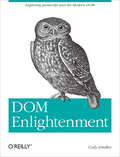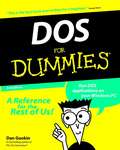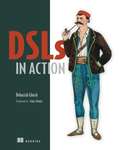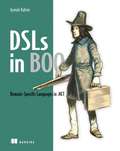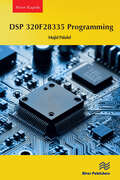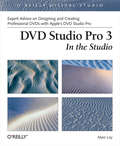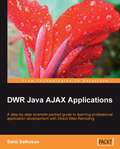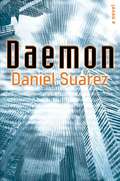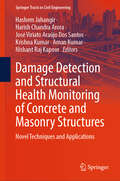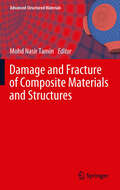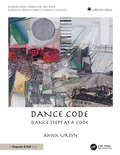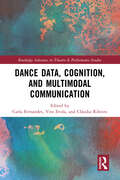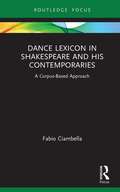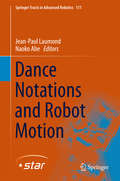- Table View
- List View
DOM Enlightenment: Exploring JavaScript and the Modern DOM
by Cody LindleyWith DOM Enlightenment, you’ll learn how to manipulate HTML more efficiently by scripting the Document Object Model (DOM) without a DOM library. Using code examples in cookbook style, author Cody Lindley (jQuery Cookbook) walks you through modern DOM concepts to demonstrate how various node objects work.Over the past decade, developers have buried the DOM under frameworks that simplify its use. This book brings these tools back into focus, using concepts and code native to modern browsers. If you have JavaScript experience, you’ll understand the role jQuery plays in DOM scripting, and learn how to use the DOM directly in applications for mobile devices and specific browsers that require low overhead.Understand JavaScript node objects and their relationship to the DOMLearn the properties and methods of document, element, text, and DocumentFragment objectsDelve into element node selecting, geometry, and inline stylesAdd CSS style sheets to an HTML document and use CSSStyleRule objectsSet up DOM events by using different code patternsLearn the author’s vision for dom.js, a jQuery-inspired DOM Library for modern browsers
DOS For Dummies
by Dan GookinWindows may rule the world of popular computing on PCs around theglobe, but DOS still has a place in the hearts and minds ofcomputer users who vaguely remember what a C prompt looks like.Even if DOS (with all its arcane commands and its drab, boringlook) isn't your idea of the best way to get things done on a PC,you'll find plenty of fast and friendly help on hand with the thirdedition of DOS For Dummies. Here's a plain-speaking reference guide to all the command-linestuff and nonsense that makes DOS work, whether you're a native DOSuser or are an occasional dabbler who needs the operating system torun all those cool games under Windows. DOS For Dummies, 3rd Edition, avoids all the technicaljargon to cut to the heart of things with clear, easy-to-understandexplanations and step-by-step help for * Changing disks and drives * Dealing with the DOS prompt * Managing files * Running DOS inside Windows * Installing and running DOS-based software programs * Working with the printer and serial ports * Using the mouse and keyboard * Troubleshooting problems * Understanding DOS error messages All the basic DOS commands, from APPEND to XCOPY, aredemystified to make life in DOS much more bearable. This handyguide has plenty of helpful tips and tricks for bending DOS to yourwill, without having to dedicate your life (and all your free time)to mastering this little corner of the PC. Author Dan Gookin's first edition of DOS For Dummiesbecame an international best-seller. He considers himself acomputer "guru" whose job it is to remind everyone that computersare not to be taken too seriously. His approach to computers islight and humorous, yet very informative. Gookin mixes hisknowledge of computers with a unique, dry sense of humor that keepsyou informed - and awake.
DSLs in Action
by Debasish GhoshYour success—and sanity—are closer at hand when you work at a higher level of abstraction, allowing your attention to be on the business problem rather than the details of the programming platform. Domain Specific Languages—"little languages" implemented on top of conventional programming languages—give you a way to do this because they model the domain of your business problem.DSLs in Action introduces the concepts and definitions a developer needs to build high-quality domain specific languages. It provides a solid foundation to the usage as well as implementation aspects of a DSL, focusing on the necessity of applications speaking the language of the domain. After reading this book, a programmer will be able to design APIs that make better domain models. For experienced developers, the book addresses the intricacies of domain language design without the pain of writing parsers by hand.The book discusses DSL usage and implementations in the real world based on a suite of JVM languages like Java, Ruby, Scala, and Groovy. It contains code snippets that implement real world DSL designs and discusses the pros and cons of each implementation. Purchase of the print book comes with an offer of a free PDF, ePub, and Kindle eBook from Manning. Also available is all code from the book. What's InsideTested, real-world examplesHow to find the right level of abstractionUsing language features to build internal DSLsDesigning parser/combinator-based little languages
DSLs in Boo: Domain Specific Languages in .NET
by Oren EiniA general-purpose language like C# is designed to handle all programming tasks. By contrast, the structure and syntax of a Domain-Specific Language are designed to match a particular applications area. A DSL is designed for readability and easy programming of repeating problems. Using the innovative Boo language, it's a breeze to create a DSL for your application domain that works on .NET and does not sacrifice performance. DSLs in Boo shows you how to design, extend, and evolve DSLs for .NET by focusing on approaches and patterns. You learn to define an app in terms that match the domain, and to use Boo to build DSLs that generate efficient executables. And you won't deal with the awkward XML-laden syntax many DSLs require. The book concentrates on writing internal (textual) DSLs that allow easy extensibility of the application and framework. And if you don't know Boo, don't worry-you'll learn right here all the techniques you need. Purchase of the print book comes with an offer of a free PDF, ePub, and Kindle eBook from Manning. Also available is all code from the book.
DSP 320F28335 Programming
by Majid PakdelThis book provides a comprehensive, practical approach to understanding and implementing the programming concepts of the DSP 320F28335 microcontroller. It is an indispensable guide for both seasoned professionals and beginners interested in mastering the complexities of programmable digital signal processors (DSPs).Inside, you will embark on a journey through the world of DSPs, exploring various programming techniques and strategies tailored specifically for the 320F28335 microcontroller. From the fundamentals of DSP programming to advanced signal processing algorithms, this book covers it all. Each chapter is carefully crafted, offering clear explanations, step-by-step examples, and hands-on exercises to reinforce your learning. You will learn how to harness the power of the 320F28335 microcontroller to develop real-time applications.Whether you are a seasoned programmer looking to expand your knowledge or a beginner ready to dive into the world of DSPs, "DSP 320F28335 Programming"" will be your ultimate companion. With its comprehensive coverage, insightful explanations, and practical examples, this book is a must-have resource for anyone aiming to excel in the realm of digital signal processing programming.
DVD Studio Pro 3: In the Studio
by Marc LoyApple's DVD Studio Pro, released in 2001, provided a low-cost, professional solution for home and small business DVD authoring. Today, the highly sophisticated yet easy-to-use DVD Studio Pro 3 allows independent filmmakers, video producers, trainers, event videographers, and enthusiasts to create professional-grade DVDs on the Macintosh platform. Pair the program with DVD Studio Pro 3: In the Studio, and you've got everything you need to embrace the digital video revolution. This indispensable book gives you the tools and know-how to master DVD Studio Pro 3. Oversized and in full color, the highly visual DVD Studio Pro 3: In the Studio is ideal for Macintosh ProApps developers--those who use Final Cut Pro 4 and Shake 3--as well as for prosumer and professional filmmakers who wish to transfer their projects to DVDs. The book goes well beyond the program's features list to demystify the entire process of DVD design and authoring. Author Marc Loy, who has been using DVD Studio Pro since its inception, goes beyond a simple discussion about the DVD Studio Pro 3 interface and entices readers to experience the program's powerful capabilities as they create eye-catching, innovative DVD designs. He covers the actual protocols involved with the DVD files and filesystems, pixel aspect ratio issues, and common "gotchas" using both still and motion media. He also delivers plenty of tips and tricks for using dynamic buttons. DVD Studio Pro 3: In the Studio explores most everything you need and want to know, including importing from Photoshop and Final Cut Pro, making motion video menus available, effective looping of video and audio, adding multilingual menus and subtitles, encoding rules for DVDs, scripting, and mass duplication hunts. DVD Studio Pro 3: In the Studio is a professional-level book for anyone who's serious about creating high-impact, professional-level DVDs to make your unique vision a digital video reality.
DWR Java AJAX Applications
by Sami SalkosuoThe initial part guides the reader through the features of DWR and how it works to make the developer ready for practical implementation. The later part contains plenty of code (with explanations) and graphical interface-driven step-by-step examples, which the reader can try out while surfing through the book to learn by doing. This book is written for competent Java developers and assumes that you are a professional rather than hobbyist. You should be familiar with the concepts of programming, Web 2.0, and AJAX.
Dad Jokes: The Laugh-out-loud edition: THE NEW COLLECTION FROM THE SUNDAY TIMES BESTSELLERS (Dad Jokes #6)
by Dad Says JokesThe iconic Instagram page @DadSaysJokes returns with a fresh batch of dad jokes to share with your nearest and dearest. With cringeworthy gags for every occasion, Dad Jokes: The Laugh-out-loud Edition is the perfect gift for Father's Day, birthdays, Christmastime and beyond. @DadSaysJokes is a community-run Dad jokes network on Instagram, Facebook and Twitter, with over 5.5 million followers, inspired by the daily jokes of author Kit Chilvers' dad, Andrew. Every day, followers submit their jokes and the team picks their favourites - or Dad just drops in his own zinger! Kit, a young social networking influencer, started his career at the tender age of 14 when he created his original platform, Football.Newz. He has since added another fourteen platforms, including @PubityPets and monster meme Instagram page @Pubity with over 31 million followers. This is his fifth book.
Dad Jokes: The Laugh-out-loud edition: THE NEW COLLECTION FROM THE SUNDAY TIMES BESTSELLERS (Dad Jokes #6)
by Dad Says JokesThe iconic Instagram page @DadSaysJokes returns with a fresh batch of dad jokes to share with your nearest and dearest. With cringeworthy gags for every occasion, Dad Jokes: The Laugh-out-loud Edition is the perfect gift for Father's Day, birthdays, Christmastime and beyond. @DadSaysJokes is a community-run Dad jokes network on Instagram, Facebook and Twitter, with over 5.5 million followers, inspired by the daily jokes of author Kit Chilvers' dad, Andrew. Every day, followers submit their jokes and the team picks their favourites - or Dad just drops in his own zinger! Kit, a young social networking influencer, started his career at the tender age of 14 when he created his original platform, Football.Newz. He has since added another fourteen platforms, including @PubityPets and monster meme Instagram page @Pubity with over 31 million followers. This is his fifth book.
Dad Jokes: The Priceless Edition (Dad Jokes #5)
by Dad Says JokesTHE NEW COLLECTION FROM THE SUNDAY TIMES BESTSELLERS @DADSAYSJOKESQ: What do cars spread on their toast?A: Traffic jam.The hit Instagram page @DadSaysJokes returns with an all-new batch of hilarious dad jokes to share with friends and family. Back by popular demand, with hundreds of gags for every occasion, Dad Jokes: The Priceless Edition is the perfect gift for Father's Day, birthdays, Christmastime and beyond.@DadSaysJokes is a community-run Dad jokes network on Instagram, Facebook and Twitter, with over 5 million followers, inspired by the daily jokes of author Kit Chilvers' dad, Andrew. Every day, followers submit their jokes and the team picks their favourites - or Dad just drops in his own zinger! Kit, a young social networking influencer, started his career at the tender age of 14 when he created his original platform, Football.Newz. He has since added another fourteen platforms, including @PubityPets and monster meme Instagram page @Pubity with its 31 million followers. This is his fifth book.
Dad Jokes: The Priceless Edition (Dad Jokes #5)
by Dad Says JokesTHE NEW COLLECTION FROM THE SUNDAY TIMES BESTSELLERS @DADSAYSJOKESQ: What do cars spread on their toast?A: Traffic jam.The hit Instagram page @DadSaysJokes returns with an all-new batch of hilarious dad jokes to share with friends and family. Back by popular demand, with hundreds of gags for every occasion, Dad Jokes: The Priceless Edition is the perfect gift for Father's Day, birthdays, Christmastime and beyond.@DadSaysJokes is a community-run Dad jokes network on Instagram, Facebook and Twitter, with over 5 million followers, inspired by the daily jokes of author Kit Chilvers' dad, Andrew. Every day, followers submit their jokes and the team picks their favourites - or Dad just drops in his own zinger! Kit, a young social networking influencer, started his career at the tender age of 14 when he created his original platform, Football.Newz. He has since added another fourteen platforms, including @PubityPets and monster meme Instagram page @Pubity with its 31 million followers. This is his fifth book.
Dad Jokes: The newest collection from the Instagram sensation @DadSaysJokes (Dad Jokes #7)
by Dad Says JokesThe must-have joke collection from the Instagram sensation @DadSaysJokesQ: How can you tell a pig is hot? A: It's bacon. The iconic Instagram page @DadSaysJokes returns with a fresh batch of dad jokes to share with your nearest and dearest. Packed with jokes so bad that they're good, Dad Jokes: The Funniest Yet is the perfect gift for every occasion. @DadSaysJokes is a community-run Dad jokes network on Instagram, Facebook and Twitter, with more than 8 million followers, inspired by the daily jokes of author Kit Chilvers' dad, Andrew. Every day, followers submit their jokes and the team picks their favourites - or Dad just drops in his own zinger! Kit, a young social networking influencer, started his career at the tender age of 14 when he created his original platform, Football.Newz. He has since added another fourteen platforms, including @PubityPets and monster meme Instagram page @Pubity with over 40 million followers. This is his seventh book.
Dad Jokes: The newest collection from the Instagram sensation @DadSaysJokes (Dad Jokes #7)
by Dad Says JokesThe must-have joke collection from the Instagram sensation @DadSaysJokesQ: How can you tell a pig is hot? A: It's bacon. The iconic Instagram page @DadSaysJokes returns with a fresh batch of dad jokes to share with your nearest and dearest. Packed with jokes so bad that they're good, Dad Jokes: The Funniest Yet is the perfect gift for every occasion. @DadSaysJokes is a community-run Dad jokes network on Instagram, Facebook and Twitter, with more than 8 million followers, inspired by the daily jokes of author Kit Chilvers' dad, Andrew. Every day, followers submit their jokes and the team picks their favourites - or Dad just drops in his own zinger! Kit, a young social networking influencer, started his career at the tender age of 14 when he created his original platform, Football.Newz. He has since added another fourteen platforms, including @PubityPets and monster meme Instagram page @Pubity with over 40 million followers. This is his seventh book.
Dad Jokes: The perfect gift from the Instagram sensation @DadSaysJokes
by Dad Says JokesTHE NEW BOOK IN THE BESTSELLING SERIESThe most followed dad jokes page on Instagram, @DadSaysJokes, returns with another collection of hilariously cringe-inducing gags for you to share with friends and family.@DadSaysJokes is a community-run Dad jokes network on Instagram, Facebook and Twitter, with over 3 million followers, inspired by the daily jokes of author Kit Chilvers' dad, Andrew. Every day, followers submit their jokes and the team picks their favourites - or Dad just drops in his own zinger! Kit, a young social networking influencer, started his career at the tender age of 14 when he created his original platform, Football.Newz. He has since added another nine platforms, including @PubityPets and monster meme page @Pubity with its 25 million followers. This is his third book.I TOLD MY WIFE SHE SHOULD EMBRACE HER MISTAKES.SHE GAVE ME A HUG.
Dad Jokes: The perfect gift from the Instagram sensation @DadSaysJokes
by Dad Says JokesTHE NEW BOOK IN THE BESTSELLING SERIESThe most followed dad jokes page on Instagram, @DadSaysJokes, returns with another collection of hilariously cringe-inducing gags for you to share with friends and family.@DadSaysJokes is a community-run Dad jokes network on Instagram, Facebook and Twitter, with over 3 million followers, inspired by the daily jokes of author Kit Chilvers' dad, Andrew. Every day, followers submit their jokes and the team picks their favourites - or Dad just drops in his own zinger! Kit, a young social networking influencer, started his career at the tender age of 14 when he created his original platform, Football.Newz. He has since added another nine platforms, including @PubityPets and monster meme page @Pubity with its 25 million followers. This is his third book.I TOLD MY WIFE SHE SHOULD EMBRACE HER MISTAKES.SHE GAVE ME A HUG.
Dad Jokes: The very best of @DadSaysJokes
by Dad Says JokesFrom the most-followed dad jokes page on Instagram, @dadsaysjokes, comes a collection of hilariously cheesy jokes that will leave your friends and family laughing and groaning in equal measure.This is the perfect gift for dads who want to expand their repertoire and anyone who fancies reminiscing about a childhood full of these no-nonsense 'bad' puns.Here are a couple of tasters:Q: Why do cows have hooves instead of feet?A: Because they lactose.Q: Are you today's date?A: Cuz you're 10/10.
Dad Jokes: The very best of @DadSaysJokes
by Dad Says JokesFrom the most-followed dad jokes page on Instagram, @dadsaysjokes, comes a collection of hilariously cheesy jokes that will leave your friends and family laughing and groaning in equal measure.This is the perfect gift for dads who want to expand their repertoire and anyone who fancies reminiscing about a childhood full of these no-nonsense 'bad' puns.Here are a couple of tasters:Q: Why do cows have hooves instead of feet?A: Because they lactose.Q: Are you today's date?A: Cuz you're 10/10.
Dads Are the Original Hipsters
by Brad GettyFrom the beloved blog comes this hilarious vintage photo collection of the OG hipsters, real dads in their glory days looking cooler than you’ll ever be.He listened to vinyl before you did. He drank whiskey before you did. He had a mustache before you did. Admit it: your dad was a hipster before you were! Based on the blog phenomenon of the same name, this book celebrates dads as the original hipsters. Vintage photos of real dads back in the day—in their short shorts and tight tees playing arcade games—accompany snarky captions that at once tip a cap to Dad’s glory days and poke fun at modern hipsters. Featuring tons of never-before-seen content, this book is perfect for dads, hipsters, and those who love to tease them!
Daemon
by Daniel SuarezEXPERIENCE THE NEW WORLD ORDER. It controls almost everything in our modern world, from remote entry on our cars and the flight controls of our airplanes to the movements of the entire world economy. Thousands of simple and autonomous computer programs, or daemons, make our networked world possible, running constantly in the background of our lives. Daemons traffic e-mail. Daemons transfer money. Daemons monitor power grids. These daemons are pervasive and, for the most part, benign. But the same can't always be said for the people who design them. Matthew Sobol was a legendary computer game designer-- the billionaire architect behind half a dozen popular online games. His premature death depressed millions of gamers around the world. But Sobol's fans aren't the only ones to note his passing. When his obituary is posted online, a previously dormant daemon activates, initiating a chain of events that may unravel the fabric of the hyperefficient, interconnected world Sobol left behind. With Sobol's secrets buried along with him, and as new layers of his daemon are unleashed at every turn, it's up to an unlikely alliance to decipher his intricate plans and wrest the world from the grasp of a nameless, faceless enemy--or learn to live in a society in which we are no longer in control.
Damage Detection and Structural Health Monitoring of Concrete and Masonry Structures: Novel Techniques and Applications (Springer Tracts in Civil Engineering)
by Krishna Kumar Aman Kumar Hashem Jahangir Harish Chandra Arora José Viriato Araújo Dos Santos Nishant Raj KapoorThis book offers the use of artificial intelligence, image processing, model analysis, laser scanners, shearography, drones, contourlet, wavelet, signal processing techniques and other SHM techniques to detect the damages in the concrete as well as masonry structures. Corrosion is one major factor that causes reinforced concrete structures to deteriorate over time. However, the degrading process is not evenly distributed throughout the structure. The damage can be detected timely and the structure's degradation model can be updated with the help of proper monitoring and inspection techniques. The damages in the masonry structures may happen due to moisture ingress, cracking, mortar failure, settlement and spalling, etc. Structure health monitoring (SHM) may assist in understanding the structures deterioration mechanisms and reducing the ongoing deterioration in a scientific manner. A complete detail of both the traditional and cutting-edge approaches used in the SHM process is described in this book. The latest non-destructive techniques and semi-destructive techniques shall also be discussed in this book. This book aids academics and industry professionals with recent developments in SHM techniques. Additionally, it encourages researchers in coming up with creation of newer applications in structural engineering.
Damage and Fracture of Composite Materials and Structures (Advanced Structured Materials #17)
by Mohd Nasir TaminThis monograph presents recent research findings on fracture properties and behavior of the composites, and their damage and cracking process under both quasi-static and impact loading conditions. Theoretical treatment, experimental investigation and numerical simulation aspects of the mechanics of composites, including sandwich structures are included.
Dance Code: Dance Steps As A Code
by Anna UrsynMany people relax when coding is introduced as a language, rather than math. Even if someone creates alone, the technology involved in the process has already been developed by somebody else. Even one person's business requires professional input from others, and collaborations are often performed online. This book mixes experiences in art, coding, music, dance, choreography, video, and stage design. Dances have unique structures and so do computer codes. In both disciplines, steps are applied following patterns, and are guided by rules and restrictions. The rules obey conditions. The Dance Code script aims to make coding less feared by readers when talking with coders on the job and typing better prompts when using artificial intelligence. In this book, a dramatized, choreographed story unfolds technical information about coding and dancing.The Dance Code script tells the story of an online interaction between a coder and a prima ballerina, resulting in a shared understanding of their respective fields. An exchange between a coder and a dancer may inspire new ways to look at visually presenting knowledge through dancing, performing, or choreographed movement. Hence, the audience learns without studying.It is a part of the “Knowledge Through the Arts” series, consisting of:Dance Code - Dance Steps as a CodeNew Storytelling - Learning Through MetaphorsCode Appreciation - Reshaping KnowledgeNature Appreciation - Knowledge as Art
Dance Data, Cognition, and Multimodal Communication (Routledge Advances in Theatre & Performance Studies)
by Carla Fernandes Vito Evola Cláudia RibeiroDance Data, Cognition, and Multimodal Communication is the result of a collaborative and transdisciplinary effort towards a first definition of "dance data", with its complexities and contradictions, in a time where cognitive science is growing in parallel to the need of a renewed awareness of the body’s agency in our manyfold interactions with the world. It is a reflection on the observation of bodily movements in artistic settings, and one that views human social interactions, multimodal communication, and cognitive processes through a different lens—that of the close collaboration between performing artists, designers, and scholars. This collection focuses simultaneously on methods and technologies for creating, documenting, or representing dance data. The editors highlight works focusing on the dancers’ embodied minds, including research using neural, cognitive, behavioural, and linguistic data in the context of dance composition processes. Each chapter deals with dance data from an interdisciplinary perspective, presenting theoretical and methodological discussions emerging from empirical studies, as well as more experimental ones. The book, which includes digital Support Material on the volume's Routledge website, will be of great interest to students and scholars in contemporary dance, neuro-cognitive science, intangible cultural heritage, performing arts, cognitive linguistics, embodiment, design, new media, and creativity studies.
Dance Lexicon in Shakespeare and His Contemporaries: A Corpus Based Approach (Studies in Performance and Early Modern Drama)
by Fabio CiambellaThis book provides a thorough analysis of terpsichorean lexis in Renaissance drama. Besides considering not only the Shakespearean canon but also the Bard’s contemporaries (e.g., dramatists as John Marston and Ben Jonson among the most refined Renaissance dance aficionados), the originality of this volume is highlighted in both its methodology and structure. As far as methods of analysis are concerned, corpora such as the VEP Early Modern Drama collection and EEBO, and corpus analysis tools such as #LancsBox are used in order to offer the widest range of examples possible from early modern plays and provide co-textual references for each dance. Examples from Renaissance playwrights are fundamental for the analysis of connotative meanings of the dances listed and their performative, poetic and metaphoric role in sixteenth- and seventeenth-century drama. This study will be of great interest to Renaissance researchers, lexicographers and dance historians.
Dance Notations and Robot Motion (Springer Tracts in Advanced Robotics #111)
by Jean-Paul Laumond Naoko AbeHow and why to write a movement? Who is the writer? Who is the reader? They may be choreographers working with dancers. They may be roboticists programming robots. They may be artists designing cartoons in computer animation. In all such fields the purpose is to express an intention about a dance, a specific motion or an action to perform, in terms of intelligible sequences of elementary movements, as a music score that would be devoted to motion representation. Unfortunately there is no universal language to write a motion. Motion languages live together in a Babel tower populated by biomechanists, dance notators, neuroscientists, computer scientists, choreographers, roboticists. Each community handles its own concepts and speaks its own language. The book accounts for this diversity. Its origin is a unique workshop held at LAAS-CNRS in Toulouse in 2014. Worldwide representatives of various communities met there. Their challenge was to reach a mutual understanding allowing a choreographer to access robotics concepts, or a computer scientist to understand the subtleties of dance notation. The liveliness of this multidisciplinary meeting is reflected by the book thank to the willingness of authors to share their own experiences with others.
